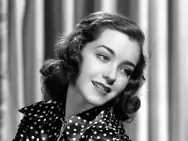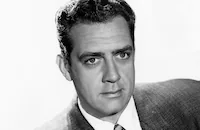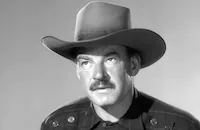Raw Deal

Brief Synopsis
Cast & Crew
Anthony Mann
Dennis O'keefe
Claire Trevor
Marsha Hunt
John Ireland
Raymond Burr
Film Details
Technical Specs

Synopsis
Joe Sullivan, who is serving time in prison for his role in a robbery, is visited by two women. First by his lawyer's assistant, Ann Martin, who appears to have more than a legal interest in him, and then by his girl friend, Pat Regan. During the visit, Pat informs him that he is to be broken out of prison that evening. Unknown to Joe, the escape has been engineered by sadistic Rick Coyle, the thief for whom Joe took the rap, in the hope that Joe will be killed, thus allowing Coyle to retain Joe's share of the robbery. However, Joe makes a successful escape and is driven away by Pat, but bullet holes in the gas tank force them to abandon the car. As they are planning to sail to Panama from San Francisco in a few days, they go to Ann's apartment to hide out. Aware that the police are setting up roadblocks, however, they decide to flee, taking Ann and her car. Pat is jealous of Ann but Joe wants her along to get them through the roadblocks more easily. After they discover that Ann's car has been identified, they stop at a gas station and steal another customer's car. Meanwhile, Coyle learns that Joe has made a clean getaway and is expecting to meet him the next evening to collect his share of the money, so he orders his henchman Fantail to kill Joe. Joe, Pat and Ann stop at a tavern run by a friend in order to switch cars again. The police surround the remote tavern when a wife murderer tries to hide out there. Eventually the killer runs out shooting and is killed by the police, who then leave, unaware that Joe is there also. Later, the three leave to collect Joe's $50,000 at a rendezvous at Grimshaw's Tackle Store, after which Joe intends to set Ann free. However, Fantail is waiting for Joe at the store, and a fight ensues, during which Ann shoots Fantail with his own gun to prevent him from killing Joe. Horrified by what she has done, Ann runs off, but Joe catches up with her and tells her that she has only wounded Fantail. After Ann and Joe realize that they are in love, Joe sends her away but she is spotted by Fantail, who follows her back to San Francisco and delivers her to Coyle. Before Joe and Pat leave, he decides to eliminate Coyle. Pat begs him not to and suspecting that he has fallen for Ann, admits that she almost phoned the police to turn him in, but changed her mind. As they are about to leave to board the freighter, Coyle discovers in which hotel they are staying and has one of his men phone to inform them that he is holding Ann prisoner. However, Pat takes the call and chooses not to relay the information to Joe. While the police keep tracking him, Joe arranges for Pat and him to be married at sea. Pat breaks down, however, and tells Joe that Coyle has Ann. When Joe rushes to rescue her, Coyle's men are waiting for him in the alley outside Coyle's house, but Joe manages to enter and confronts Coyle. Although Coyle assures him that he will give him the money, he double-crosses Joe again and shoots him. Joe returns fire, injuring Coyle and, as the room catches fire, they struggle until Joe pushes Coyle through a window to his death. Joe then rescues Ann, but as Pat and the police arrive, he dies in Ann's arms.

Director

Anthony Mann
Cast

Dennis O'keefe

Claire Trevor

Marsha Hunt

John Ireland

Raymond Burr
Curt Conway
Chili Williams

Regis Toomey

Whit Bissell
Cliff Clark
Paul Kruger
James Magill
Victor Cutler
John Daheim
Abe Dinovitch
Carey Loftin

Gregg Barton
Richard Irving
Alex Davidoff
Joan Myles
Edna Ryan
Mike Lally
Lloyd Everett
Harry Tyler
Ilka Gruning
David Clarke

Ray Teal
Robert Williams
Vincent Graeff
Tom Fadden
Arnold Stanford
Robert Bice
Willard Kennedy
Frank Hyers
Crew
John Alton
Arnold B. Armstrong
Audrey Ashley
Leopold Atlas
Leon S. Becker
Ridgeway Callow
Alfred Degaetano
France Ehren
Irving Friedman
John C. Higgins
Edward L. Ilou
Louis Kusley
Ted Larsen
Don Mackenzie
Anna Malin
Armor Marlowe
Jack R. Rabin
Paul Sawtell
Lester Shorr
Earl Sitar
Edward Small
Joan St. Oegger
Clarence Steenson
George J. Teague
Leslie Urbach
James T. Vaughn
Richard Walton
Ern Westmore

Photo Collections
Videos
Movie Clip



Hosted Intro
Film Details
Technical Specs

Articles
Raw Deal (1948)
Made for Eagle-Lion Studios, Raw Deal is the fourth in a string of 'B' noirs that Mann directed in the 1940s. His previous film, T-Men (1947), had been a breakthrough for the director (not to mention Eagle-Lion), and with the equally fine Raw Deal it was obvious that Mann had serious, consistent talent. So did his cameraman, John Alton, who is now recognized as one of the industry's finest cinematographers. Time and again, the pair created something interesting out of very little by imaginatively finding visual ways to heighten audience involvement and deepen characters.
Raw Deal, in fact, has much deeper characterizations than is the norm for such a cheap programmer. The rather implausible screenplay by John C. Higgins (another T-Men alum) finds Dennis O'Keefe in jail for a crime he didn't commit. He has taken the rap for his gangster boss, Raymond Burr, and now they have hatched an escape plan. But Burr, who was actually hoping that O'Keefe would die trying to escape, grows nervous when he hears that O'Keefe has busted out successfully and is now heading his way.
Woven tightly into this story thread are two female characters, one good and one bad, and it's hard not to see them as representing two forces pulling O'Keefe in two directions. Claire Trevor is the moll who helps O'Keefe escape and dreams of a life with him. Marsha Hunt, meanwhile, is a social worker who had visited O'Keefe in prison trying to help him. He now kidnaps her, and the three spend the bulk of the movie on the road with the cops in pursuit. When O'Keefe starts falling for Hunt, Trevor grows jealous. Thanks to a plot turn, Hunt's fate ultimately rests in Trevor's hands, and the question of whether she will do the right thing to save her becomes an intriguing and even poignant one - as well as an excuse for one of the most ingenious compositions in the picture, with Trevor's face reflected on the face of a clock.
Trevor, one of the supreme bad girls of film noir (Murder, My Sweet 1944, Born to Kill, 1947) is actually a grounding force for the audience from the film's opening moments. When her ghost-like, present-tense narration washes over the soundtrack, it's clear that this will be a movie in which tone and atmosphere are everything. Her narration, for instance, lends strong fatalism. The movie's overall design, with almost every scene set at night, gives a feel of a world that is dark and despairing. And with O'Keefe framed over and over in confined spaces, the movie suggests that he never "escaped" from prison.
Raw Deal's world is also one of brutal violence. A fistfight in a taxidermy shop between O'Keefe and John Ireland (extremely good as one of Burr's henchmen), is visceral and shocking thanks largely to sound. It goes on and on, with sound effects making the blows land with very loud thuds - so solid you can almost feel them. An off-screen torture of one character is all the more powerful for being implied rather than shown. And Raymond Burr's pyromania makes even the flicking of a cigarette lighter ominous.
Burr may have been an effective fixture in film noir in the late 1940s, but his "Rick" in Raw Deal is actually an underwritten bad guy made menacing and scary entirely by directing choices, such as low camera angles and gaudy costumes. As film historian Jeanine Basinger has written, "Without Mann and Alton's mastery of form, Rick would be a dull villain, dependent on Burr's girth for his originality. By enhancing his evil through camera angles, decor, and the fire motif, a character was deepened - created, really - where none existed before." These kinds of touches elevate the picture. Mixed with Mann's fine pacing skills, they add up to a movie that is a lot more exciting, touching and dramatic than it ever really deserved to be.
Producer: Edward Small
Director: Anthony Mann
Screenplay: Arnold B. Armstrong, Audrey Ashley, Leopold Atlas, John C. Higgins
Cinematography: John Alton
Film Editing: Alfred DeGaetano
Art Direction: Edward L. Ilou
Music: Paul Sawtell
Cast: Dennis O'Keefe (Joseph Emmett Sullivan), Claire Trevor (Pat Cameron), Marsha Hunt (Ann Martin), John Ireland (Fantail), Raymond Burr (Rick Coyle), Curt Conway (Spider).
BW-79m.
by Jeremy Arnold

Raw Deal (1948)
Quotes
Trivia
Notes
This film's working title was Corkscrew Alley. Although the onscreen credits list Richard Fraser in the role of policeman "Fields," that part was played by Regis Toomey. The CBCS lists Sam Bernard in the role of "motel manager," but no such character appeared in the viewed print.
















